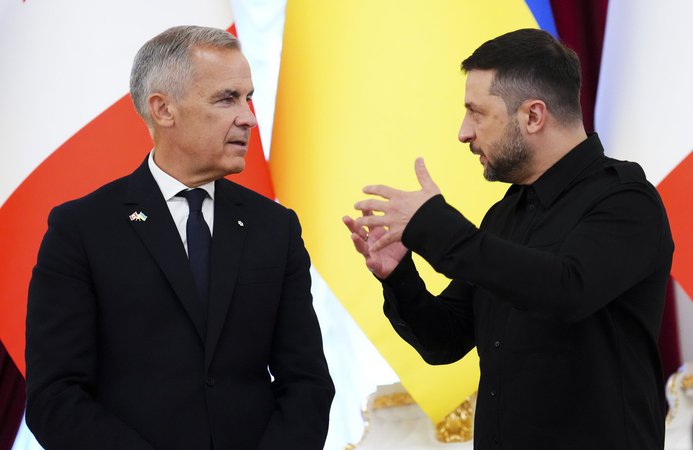Business
Canada Faces Criticism Over Ukraine Aid Claims and Contributions

Canada has come under scrutiny following Prime Minister Mark Carney‘s recent visit to Ukraine, where he announced nearly $22 billion in assistance pledged to the country. Social media backlash arose after the Prime Minister’s Office inaccurately claimed that Canada has made the “highest per capita contribution among G7 countries” since the onset of Russia’s full-scale invasion in February 2022. While Canada does lead in direct financial assistance per capita among G7 nations, it does not hold the top position in overall contributions.
The Prime Minister’s Office stated in a news release coinciding with Ukraine’s Independence Day that Canada’s commitment exceeds $22 billion in multifaceted assistance. This figure includes military, humanitarian, and development aid. Despite this substantial pledge, critics on social media highlighted the misleading nature of the per capita claim, which has been widely circulated, with one post garnering over 4,000 likes and suggesting that Canada is the largest donor overall on a per capita basis.
Understanding the Financial Contributions
Canada’s direct financial assistance to Ukraine amounts to slightly over $12.3 billion, translating to about $296 per person based on Canada’s population of approximately 41.55 million. In contrast, the United States has committed about US$56.95 billion (approximately C$78.3 billion), which equates to around $229 per person, given its population of about 342.38 million.
The revised statement from the Prime Minister’s Office now accurately reflects that Canada holds the highest per capita contribution among G7 countries for direct financial support. It is essential to note that the total contributions, which include military and humanitarian aid, position the United States ahead of Canada in overall funding. Canada’s total aid commitment of nearly $22 billion breaks down to about $529 per person, while the U.S. total is about $544 per person.
Countries outside the G7, such as Norway and Denmark, have also surpassed both Canada and the U.S. in per capita contributions, with Norway committing $31.1 billion (approximately $5,554 per capita) and Denmark $15.9 billion (approximately $2,650 per capita) according to data from the Kiel Institute for the World Economy.
Details of Aid Commitments
Canada’s aid package encompasses various forms of assistance, including military, humanitarian, and development funds. However, much of the financial assistance comprises loans, with approximately $12.1 billion of the $12.3 billion being in loan form, which typically matures ten years after issuance. A significant portion of this, $4.8 billion, is part of a mechanism announced in June 2024 that utilizes interest from frozen Russian assets to facilitate loans.
Meanwhile, the Canadian government has pledged $6.5 billion in military assistance through 2029, with the funds earmarked for various military needs including armored vehicles and drones. Additionally, the country has committed $372.2 million in humanitarian assistance aimed at providing emergency health services and support for displaced populations, along with $700 million for development aid addressing issues such as mental health and agricultural needs.
The situation is compounded by the ongoing Russian propaganda campaign, which often targets foreign aid to Ukraine. Misinformation regarding government corruption and alleged misuse of funds has proliferated, complicating public perception. The Canadian Press highlighted how false claims regarding Ukrainian President Volodymyr Zelenskyy purchasing luxury yachts were circulated, only for it to emerge that the story was fabricated.
Despite these narratives, public support for Ukraine remains strong in Canada. A recent poll by the Angus Reid Institute indicated that a majority of Canadians favor further assistance, particularly in the form of peacekeeping efforts, if a resolution is reached between Ukraine and Russia. The survey revealed that while 39 percent of respondents believe Canada has provided an appropriate level of support, others expressed differing views on the adequacy of aid.
In summary, while Canada’s contributions to Ukraine are significant, the context of those contributions is crucial for public understanding. The evolving narrative around aid, coupled with the complexities of international relations and misinformation, continues to shape discussions about support for Ukraine on the world stage.
-

 Science2 months ago
Science2 months agoToyoake City Proposes Daily Two-Hour Smartphone Use Limit
-

 Health2 months ago
Health2 months agoB.C. Review Reveals Urgent Need for Rare-Disease Drug Reforms
-

 Top Stories2 months ago
Top Stories2 months agoPedestrian Fatally Injured in Esquimalt Collision on August 14
-

 Technology2 months ago
Technology2 months agoDark Adventure Game “Bye Sweet Carole” Set for October Release
-

 World2 months ago
World2 months agoJimmy Lai’s Defense Challenges Charges Under National Security Law
-

 Technology2 months ago
Technology2 months agoKonami Revives Iconic Metal Gear Solid Delta Ahead of Release
-

 Technology2 months ago
Technology2 months agoSnapmaker U1 Color 3D Printer Redefines Speed and Sustainability
-

 Technology2 months ago
Technology2 months agoAION Folding Knife: Redefining EDC Design with Premium Materials
-

 Technology2 months ago
Technology2 months agoSolve Today’s Wordle Challenge: Hints and Answer for August 19
-

 Business2 months ago
Business2 months agoGordon Murray Automotive Unveils S1 LM and Le Mans GTR at Monterey
-

 Lifestyle2 months ago
Lifestyle2 months agoVictoria’s Pop-Up Shop Shines Light on B.C.’s Wolf Cull
-

 Technology2 months ago
Technology2 months agoApple Expands Self-Service Repair Program to Canada









